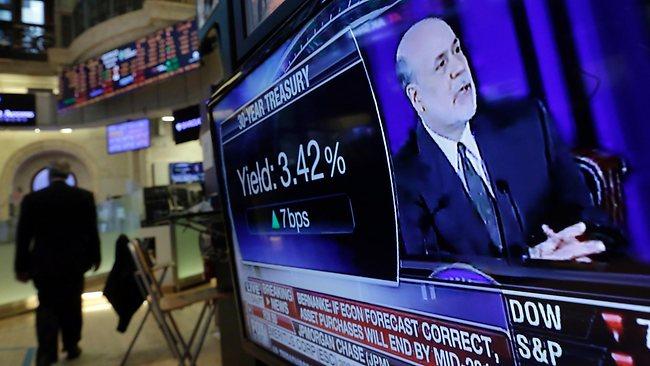
THE past week's financial turbulence seems somewhat paradoxical. After all, Wednesday's statement by Ben Bernanke, chairman of the US Federal Reserve, which triggered the largest fall in US stockmarkets in a year, reflected the Fed's perception of an improving outlook for the American economy.
That could create the conditions for the Fed to wind back its $US85 billion ($92bn)-a-month bond-buying program later this year and discontinue it altogether by the middle of next year.
Bernanke has committed to ending the Fed's "quantitative easing" program once the US unemployment rate is down to 7 per cent, though the Fed won't raise its cash rate until unemployment reaches 6.5 per cent; last month, the unemployment rate stood at 7.6 per cent and the Fed now expects it to reach 6.5 to 6.8 per cent by late next year.
That should be good news. But investors are anxious about the consequences of a reduction in the Fed's stimulus program; and those anxieties are compounded by worrying signs for the world economy.
The result is intensified uncertainty, with important implications for Australia.
In part, that uncertainty stems from the exceptional nature of the interventions undertaken by the Fed and other central banks since 2008, both in their scale and methods. Blurring the dividing lines between monetary and fiscal policies, central banks have aggressively acquired financial assets, shifting from being lenders of last resort to the banking system to being the financial markets' dealers of last resort.
In the process, they have enormously expanded their balance sheets, not only by buying government bonds but also other financial instruments.
For example, the Fed's holdings of financial assets rose from insignificance when the credit market turmoil began in August 2007 to about $US1 trillion by February 2009, before reaching $US3.4 trillion early this month.
The effects of this unprecedented expansion in central banks' balance sheets are contentious. Critics argue that expansion can shift significant risk on to governments, unnecessarily exposing the central banks themselves, and ultimately taxpayers, to losses and controversial disputes regarding credit allocation.
But as well as those concerns, there are also difficulties in assessing the impacts of "quantitative easing" on financial markets and economic activity more generally, raising questions about the effects if and when the policies are unwound.
The theory advanced by supporters of these policies is straightforward. When a central bank purchases assets (such as government bonds) it increases the money holdings of the sellers, who will then use some of those funds to buy other financial assets, including shares and corporate bonds, raising their price.
Those higher asset prices increase the net wealth of asset holders and also imply lower yields, which should reduce borrowing costs for firms and households, stimulating demand and pushing up economic activity. And those effects will partly spill overseas, reducing the exchange rate and boosting financial markets internationally.
But these are uncharted waters and that account abstracts from many complexities; even were it accepted, however, there are sharp differences of view both about the extent and durability of the impacts and about the risk of simply unleashing asset price bubbles. The Fed's approach of linking its monetary policy to the unemployment rate (rather than to an inflation target) compounds those uncertainties, as financial markets have fewer means of signalling expectations of unemployment than of inflation.
With all those matters in doubt, financial markets are skittish about the Fed simply reversing course, worrying that a poorly timed reversal could lead to a large shift in funds from equities back into the markets for government bonds, placing sharp downward pressure on share prices, while raising interest rates to US businesses and consumers.
To make matters worse, the rest of the world economy is far from being in great shape. Share prices in emerging markets, such as Brazil, have taken a battering in recent months, with Latin American stocks approaching their lowest level since 2009.
The prospect of higher interest rates in the US is likely to intensify those falls, further damaging confidence and accelerating the already steep decline in emerging economy exchange rates (which are close to a post-crisis low).
Nor is China, which has acted as a locomotive for Australian growth, immune from the difficulties. China's growth rate dropped to 7.7 per cent in the first quarter of this year, and is believed to have fallen further since then.
Until now, the government would have responded to that slowing through stimulus programs; but faced with a property price bubble, it seems willing to allow a credit crunch to develop, as the backdrop to economic reform measures due to be announced later this year. Then there is Europe, which has yet again proven its relevance as only it knows how: by getting into an unholy mess. Although the prospects of the euro collapsing have abated, the eurozone remains mired in low or negative growth, with France, Belgium, The Netherlands and Finland all facing a new round of belt-tightening.
And last but not least, there are uncertainties about the US itself. Monthly private sector job creation is up slightly, while mass layoffs are down, but almost all the other indicators point to a labour market that, at best, is recovering slowly and unevenly.
And the Fed has tended to overestimate the pace of growth in the past. It has twice ended its bond-buying programs only to restart them when it became clear its optimistic forecasts were not being met.
All this adds up to an outlook laden with downside risks. Markets are usually good at managing the uncertainties that arise from the behaviour of economic agents, but many of these risks are due to governments, whose decisions tend to be difficult to predict, large in scale and unresponsive to changing circumstances.
That should induce governments to be cautious, including in the setting of monetary policy; all too often, however, they have failed to heed Milton Friedman's admonition against "assigning to monetary policy a larger role than it can perform, asking it to achieve tasks it cannot achieve, and, as a result, preventing it from making the contribution it is capable of making". The "unconventional" measures Bernanke is proposing to unwind may become an object lesson in the costs ignoring that warning can impose, not least because of the difficulties involved in reversing course.
Those risks make it crucial to increase our own economy's ability to absorb the shocks that lie ahead.
The Gillard government, however, is set on doing the exact opposite, entrenching labour market rigidities, increasing the cost burden on business and locking in unsustainable spending commitments. It is now up to the Coalition to show it can do better.



